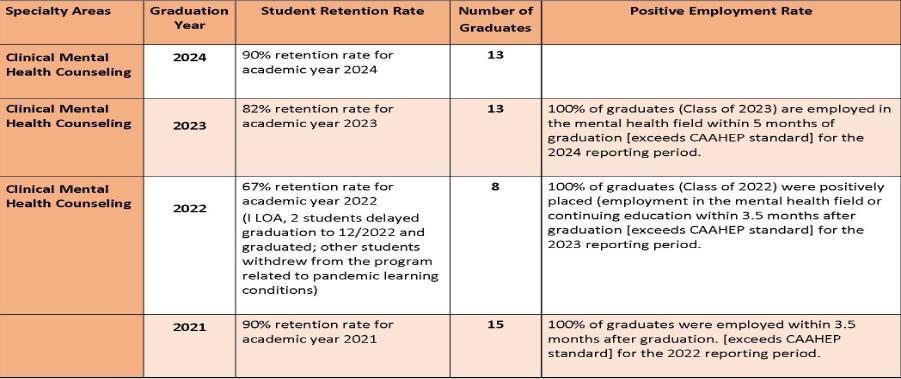Counseling & Art Therapy Technical Standards
1.0 Observation Skills Technical Standard
1.01 Demonstrate sufficient attention and accuracy in observation skills (visual, auditory, and tactile) in the classroom, lecture hall, studio, and internship settings.
1.02 Indicators include, but are not limited to, these examples:
- Accurate observations of a patient near and at a distance; recognizing non-verbal and verbal signs.
- Accurate identification of differences in color, texture, shape, and other formal elements of artwork.
- Accurate visualization and discrimination of text, numbers, patterns, graphic illustrations, and key characteristics of other images.
2.0 Communication Skills Technical Standard
2.01 Demonstrate effective communication skills with all ages and genders of patients who have a variety of diagnoses, disabilities, cultures, ethnicities, and personalities.
2.02 Indicators include, but are not limited to, these examples:
- Clear, efficient, and intelligible articulation of verbal language.
- Legible, efficient, and intelligible written English language.
- Accurate and efficient reading skills (English language).
- Ability to prepare and communicate concise oral and written summaries of patient encounters.
- Ability to accurately follow oral and written directions.
3.0 Critical Reasoning Skills Technical Standard
3.01 Demonstrate critical reasoning skills, including, but not limited to, intellectual, conceptual, integrative, and quantitative abilities.
3.02 Indicators include, but are not limited to, these examples:
- Demonstrate ability to measure, calculate, reason, analyze, integrate, and synthesize information.
- Demonstrate ability to acquire, retain, and apply new and learned information.
- Demonstrate appropriate judgment in patient assessment, diagnosis, monitoring, and evaluation, including planning, time management, and choice of art materials.
4.0 Motor And Sensory Function Technical Standard
4.01 Demonstrate sufficient motor and sensory function to perform typical functions of art therapists, including, but not limited to, assessments, evaluations, and individual, group, and family treatment.
4.02 Indicators include, but are not limited to, these examples:
- Functional and sufficient sensory capacity (visual, auditory, and tactile) to adequately perform a complete Art Therapy Projective Imagery Assessment (AT-PIA).
- Execute motor movements to assess patients, provide assistance with art materials and techniques, and implement basic art therapy processes.
- Execute motor movements that demonstrate safety and efficiency in the various learning settings (i.e., classroom, lecture hall, and clinical settings).
- Properly use art materials and tools for art making, including but not limited to, drawing implements, brushes, clay tools, glue guns, etc.
- Physical stamina sufficient to complete the rigorous course of a didactic and clinical study, which may include prolonged periods of sitting, standing, and/or rapid ambulation.
5.0 Behavioral And Social Attributes Technical Standard
5.01 Demonstrate the behavioral and social attributes vital to participation in a professional program and service as a practicing professional art therapist.
5.02 Indicators include, but are not limited to, these examples:
- Possess the emotional health required for full utilization of mental faculties (judgment, orientation, affect, and cognition).
- Ability to develop mature and effective professional relationships with faculty, patients, the public, and other members of the health care team.
- Possess personal qualities that facilitate effective therapeutic interactions (compassion, empathy, integrity, honesty, benevolence, confidentiality).
- Demonstrate impartial motives, attitudes, and values in roles, functions, and relationships.
- Ability to monitor and react appropriately to one’s own emotional needs and responses.
- Display appropriate flexibility and adaptability in the face of stress or uncertainty associated with clinical encounters and clinical environments.
- Compliance with standards, policies, and practices outlined in the ATC Student Handbook.
Reasonable Accommodations: Macon & Joan Brock Virginia Health Sciences at Old Dominion University are committed to diversity and to attracting and educating students who will make the population of healthcare professionals' representative of the national population. We provide confidential and specialized disability support and are committed to excellence in accessibility; we encourage students with disabilities to disclose and seek accommodations. Students who, after review of the technical standards determine that they require accommodation(s) to fully engage in the program, should contact the Student Disability Services Department (StudentDisability@odu.edu) to confidentially discuss their accommodations needs. Accommodations are never retroactive; therefore, timely requests are essential and encouraged.



